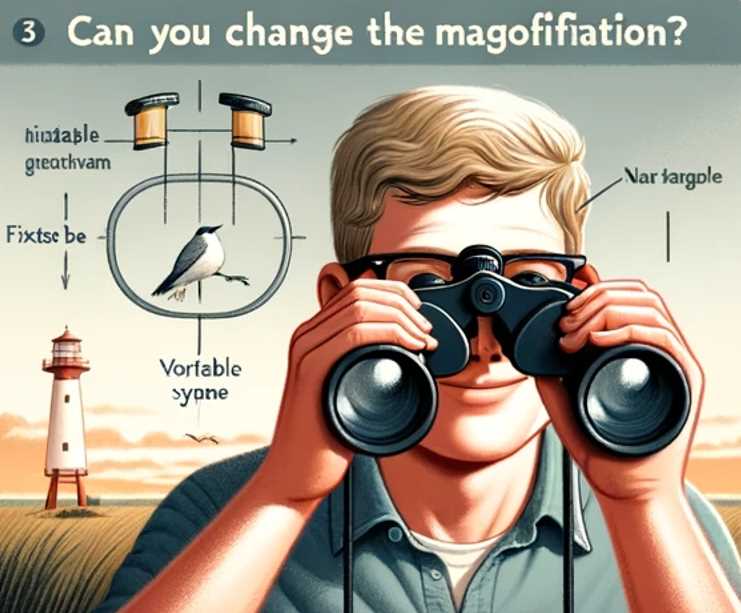No, it is not possible to reduce the magnification of binoculars. Binoculars have a fixed magnification determined by their optical design, precisely the combination of lenses and prisms. Unlike zoom binoculars, where you can adjust the magnification, standard binoculars have a fixed magnification that cannot be altered.

| Binocular Type | Magnification | Adjustable Magnification? |
|---|---|---|
| Standard Binoculars | Fixed | No |
| Zoom Binoculars | Variable | Yes |

Can You Change the Magnification of Binoculars?
Binoculars have long been an essential companion for enthusiasts like me, offering a closer look at the wonders of nature. The burning question that often arises is whether it’s possible to tweak the magnification settings of binoculars. Let’s embark on a journey into the world of binocular magnification and explore the nuances of adjusting this fundamental feature.
Fixed vs. Variable Magnification
Binoculars generally fall into two categories: those with fixed magnification and those with variable magnification. Fixed magnification binoculars have a predetermined zoom level, such as 8x or 10x, which cannot be altered. On the other hand, binoculars with variable magnification provide users with the flexibility to adjust the zoom according to their preferences. The latter is particularly appealing for individuals engaged in diverse activities, from bird watching to stargazing.
Technical Aspects of Binocular Design
The ability to change magnification is intricately tied to the technical design of binoculars. In fixed magnification models, the lenses and prisms are meticulously calibrated to achieve a specific level of zoom. In contrast, variable magnification binoculars incorporate mechanisms that allow users to modify the magnification settings. These mechanisms, often involving a zoom lever or ring, enable a seamless transition between different levels of zoom.
Real-world Examples and Personal Experiences
In my own exploration, I’ve encountered both fixed and variable magnification binoculars. The fixed magnification provided a stable and predictable viewing experience, ideal for activities where a consistent zoom level is preferred. However, it was the variable magnification binoculars that truly captured my interest.
During bird-watching excursions, the ability to adapt magnification on the fly significantly enhanced my experience. Spotting a distant bird perched on a tree branch became an immersive endeavor as I could seamlessly zoom in for intricate details and zoom out for a broader view of the surrounding environment.
| Aspect | Fixed Magnification Binoculars | Variable Magnification Binoculars |
|---|---|---|
| Consistency | Provides a stable and consistent zoom level. | Allows users to adapt the magnification to suit scenarios. |
| Flexibility | Limited flexibility in adjusting magnification. | Offers a range of zoom levels for versatile use. |
| Weight | Generally lighter due to simpler internal optics. | May be heavier due to the complexity of variable mechanisms. |
| Learning Curve | Easy to use, suitable for beginners. | May require some learning to master variable adjustments. |
These tables highlight the advantages and disadvantages of both fixed and variable magnification binoculars, aiding users in making informed decisions based on their specific needs and preferences.
During my bird-watching escapades, I have personally experienced the difference between fixed and variable magnification binoculars. The ability to adapt magnification on the fly significantly enhanced my birding experience, enabling me to zoom in for intricate details and zoom out for a broader view of the landscape.
Factors Influencing Binocular Magnification
Binocular magnification is a critical aspect that greatly influences the viewing experience. Understanding the various factors that contribute to magnification is essential for enthusiasts and users seeking optimal clarity and precision in their observations.
Objective Lens Diameter
One significant factor influencing binocular magnification is the diameter of the objective lens. This measurement, often expressed in millimeters, plays a crucial role in determining the potential magnification a pair of binoculars can achieve. Larger objective lenses allow more light to enter the binoculars, providing a brighter image and, in some cases, supporting higher magnification.
Relationship Between Objective Lens Diameter and Magnification
The relationship between the objective lens diameter and magnification is noteworthy. As the diameter increases, the potential for higher magnification also grows. However, it’s essential to strike a balance, as excessively large objective lenses can result in heavier and bulkier binoculars, impacting their portability and ease of use.
Field of View
Another pivotal factor affecting binocular magnification is the field of view. Field of view refers to the width of the observable area when looking through the binoculars. While increased magnification allows for detailed observations of distant objects, it often comes at the expense of a narrower field of view.
Impact on Observational Experience
The impact of field of view on the observational experience cannot be overstated. Binoculars with wider fields of view are ideal for activities where a broader perspective is crucial, such as bird watching or scanning expansive landscapes. Conversely, higher magnification binoculars are favored when intricate details of distant objects need to be examined.
Eyepiece Design
The design of the eyepiece is yet another factor that contributes to binocular magnification. Different eyepiece designs can enhance or limit the overall magnification capabilities of a pair of binoculars.
Role of Eyepiece Design in Magnification
The eyepiece design influences the final magnified image presented to the observer. Some eyepieces are specifically engineered to support higher magnification while maintaining image clarity, making them suitable for activities such as astronomy. On the other hand, certain designs prioritize a wider field of view, catering to users who prefer versatility over extreme zoom capabilities.
| Eyepiece Type | Characteristics |
|---|---|
| Wide-Angle Eyepieces | Emphasize a broader field of view |
| Zoom Eyepieces | Allow variable magnification settings |
| High-Power Eyepieces | Optimize for detailed, distant viewing |
What is the Minimum Magnification for Binoculars?

Curiosity led me to explore the concept of minimum magnification in binoculars. The minimum magnification is the lower limit of zoom a pair of binoculars can offer. Some binoculars are specifically designed with low magnification options, catering to users who prioritize a wider field of view over extreme zoom.
During my nature hikes, I found binoculars with lower magnification to be invaluable. They allowed me to scan vast landscapes effortlessly, making it easier to spot distant wildlife or appreciate the grandeur of panoramic views.
Tips for Reducing Binocular Magnification

As I navigated through the world of binoculars, I discovered various tips for reducing magnification. Simple adjustments to the eyepieces can personalize the viewing experience. Additionally, there are accessories available, such as magnification-reducing lenses, which can be attached to the eyepieces for a customized level of zoom.
I experimented with these tips during my stargazing adventures, finding that they added a layer of flexibility to my observations. Being able to fine-tune the magnification opened up new possibilities for exploring the night sky.
Advantages and Disadvantages of Adjustable Magnification
While adjustable magnification offers versatility, it comes with its own set of pros and cons. The ability to adapt to different scenarios is undoubtedly an advantage. However, the complexity of variable magnification systems can lead to increased weight and a steeper learning curve for users.
I shared my experiences with fellow enthusiasts, discussing the benefits of adjustable magnification during our group outings. It became apparent that finding the right balance between flexibility and simplicity is crucial for an enjoyable binocular experience.
Final Words
In conclusion, the ability to adjust binocular magnification is a fascinating aspect that adds a dynamic layer to our observation experiences. Whether fixed or variable, understanding the factors influencing magnification is key for enthusiasts like myself. As technology continues to evolve, I am excited about the potential breakthroughs that could further enhance the adaptability of binoculars.
Resources and References
- “Binoculars: How to Choose” – A comprehensive guide by the Cornell Lab of Ornithology. Cornell Lab Guide
- “Understanding Binoculars: Magnification, Objective Lens Diameter, and Exit Pupil” – An informative article by B&H Explora. B&H Explora Article
- “Choosing Binoculars for Bird Watching” – Tips and recommendations from the Audubon Society. Audubon Society Tips
- “Binoculars: A Guide to Specs and Features” – An overview of binocular specifications and features by Optics Planet. Optics Planet Guide
- “How to Choose Binoculars” – A user-friendly guide from REI for selecting the right binoculars for your needs. REI Binoculars Guide

I am an enthusiastic student of optics, so I may be biased when I say that optics is one of the most critical fields. It doesn’t matter what type of optics you are talking about – optics for astronomy, medicine, engineering, or pleasure – all types are essential.
Table of Contents

Pingback: What causes binocular vision dysfunction?